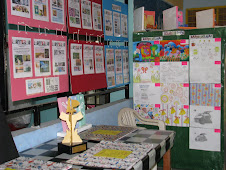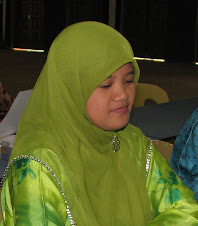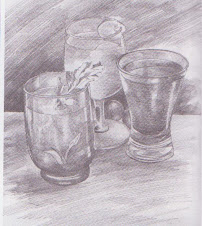Painting
Expression of Malaysian culture in painting.
A Malaysian beauty is captured on canvass
An artist diligently at work to complete a Chinese caligraphy.
Perhaps amongst all the arts, painting is the one that has come closest towards the ideal concept of Malaysian art. Since Independence in 1957, there has arisen a strong school of painting which has a vigorous Malaysian character and which is the product of Malaysian painters of all races. Their art expresses and reflects the spirit and personality of a multiethnic and multicultural society, informed by a genuine contemporary sensibility which forms the basis of their search for national identity.
The National Art Gallery, which was set up in 1958, plays a key role as the matrix from which has emerged this national identity and a common avenue for Malaysians to give shape to their feelings and visions. The national gallery assists other states in Malaysia to establish their own art galleries.
An important milestone on the Malaysian art scene was the establishment of the Specialists’ Teacher’s Training Institute (STTI) in Kuala Lumpur in 1960. The best STTI-trained teachers were sent to the United Kingdom for further studies, and upon their return added impetus to the art movement of the 60s. Some of them became active artists, such as Ahmad Khalid Yusof, Reza Piyadasa, Grace Selvanayagam and Chew Teng Beng.
In 1965, the Institut Teknologi Mara (ITM) was created, inaugurating a new era in the field of art education in the country. Its School of Fine and Applied Arts introduced an organised programme of courses in painting, graphic design, textile design, fine metal and industrial arts.
Another landmark development was the establishment of the Malaysian Institute of Art in Kuala Lumpur in 1967. The courses offered at this Beaux-Arts type school were directed towards employment-based activities such as Commercial Art and Interior Design.
During that period, several artists and painters went abroad - to Australia, France, Germany, India, Japan, United Kingdom and the United States, to further develop their style and techniques. The exposure afforded them a unique opportunity for maturing into profound artists with an awareness of special dimensions. These encounters between different cultures gave rise to new dimensions of values in Malaysian art, leaving a massive cultural impact which can be felt till this day.
The 60s also witnessed punchy oil works by Sui-Hoe, Latiff Mohidin and Soo Pieng. These used to hang side by side with delicate Chinese brush paintings by Chung Chen Sun and Chen Wen Hsi at their best; in the company of Ibrahim Hussein’s creative piece or Chia Yu Chian’s charming creation.
A number of Malaysian artists participated in the ‘First Triennial of Contemporary World Art’ in New Delhi in 1968, but did not win any awards. Nevertheless, their effort did not go unnoticed by Howard Taubmann, critic-at-large of the New York Post, who observed:
"Another country that has a right to be pleased with its showing is Malaysia. Its display includes examples of uninspired realism and impressionism, but one also finds provocative attempts to place traditional themes in modern contexts. The Malaysians did not win any prizes, but they may well surprise the next Triennial.
In the early post-Independence years, Malaysian art was also exhibited in Glasgow, Dublin, London, Cologne, Berlin, Hamburg, St. Etienne, and Paris, where it received rave reviews. Robert Barret wrote in the Paris ‘La Quadtidienne’ in 1967 that the works were undeniably sincere, ‘an interesting vision of the world, sometimes a certain philosophical approach but always the will to get away from the beaten tracks in painting and sculpture’.
Contemporary Malaysian painting bloomed in the 90s, with the phenomenon centred in the capital Kuala Lumpur. The artist population, too, has increased manifold, and their styles are varied, utilising diverse art materials and covering a broad range of subjects. Art collectors and enthusiasts have to literally navigate through art galleries and exhibition centres to view and to purchase unique works of art.
In Kuala Lumpur, the Central Market - where artists do crayon portraits of clients in the midst of curious onlookers, would be the most convenient venue to purchase contemporary works; while in Penang, the Universiti Sains Malaysia (USM Art Gallery is highly recommended.
There are also commercial galleries such as the Citarasa Gallery, A.P Gallery and Room at the Top that charge 30 per cent of the sales in an exhibition mounted by them. It is considered reasonable by most artists as the gallery owners organise and stage the entire event, from printing and mailing invitations up to serving refreshments to guests on the big day.
Both the MARA Universiti Teknologi Mara (ITM) and the Malaysian Institute of Art (MIA),hold regular graduate exhibitions, details of which are listed in the national newspapers.
Prestigious exhibition spaces such as the Creative Centre of the National Art Gallery, the Maybank Art Gallery, the Dayabumi Exhibition Hall, the Petronas Gallery, and the lobbies of the Shangri-La and Hilton hotels, are sought after by artists who negotiate for a week or two of show dates. As the schedule for the year is often fully booked, a breakthrough can mean instant fortune for some artists (to the tune of RM 40,000 = about US$10,500).
An established artist like Chuah Thean Teng sells his works in his own premises, a gallery called Ya-hong in Batu Feringghi, Penang. Ibrahim Hussein conducts direct selling of his paintings from his residence which serves as a studio-cum-gallery. Their duo’s successful careers exemplify the virtues of hard work, persistence and self-promotion.
Latiff Mohidin purchased two houses, and converted one into a studio-cum-gallery where he displays his recent works. A perennial outsider on the local art scene, his gallery, which is managed by his wife, has earned quite a reputation mostly by word of mouth.
Regular corporate buyers of art works are the National Bank of Malaysia, Bank Rakyat, Maybank, Bank Bumiputra, Petronas, Esso, Shell and Malaysia Airlines. The Sime Darby headquarters in Kuala Lumpur has 14 paintings by Ibrahim Hussein along its corridors estimated to be worth between RM700,000 and RM800,000 (between US$184,000 to about US$210,000). The National Bank has collected a great number of works over the years that it now has its own gallery to hang them, and has even published two books to show off its collection. EON and Petronas help to educate the public about Malaysian art by reproducing art works in calendars.
The works in the National Art Gallery depict the various developments that have taken place in the Malaysian world of painting. Among them are:
• Creative pieces by pioneers like Yong Mun Sem, Chuah Thean Teng and Datuk Hoessein Enas
• Paintings with Chinese pictorial treatment by Chia Yu-Chian of the Paris School
• Erotic-surrealism by Long Thien Shih
• Pop art by Joseph Tan
• Abstract expressionism by Syed Ahmad Jamal and Cheong Lai Tong
• Conceptual art by Redza Peyadasa
• Islamic revivalism by Sulaiman Esa, Ahmad Khalid Yusof and Zakaria Awang
• Back-To-Roots tradition by Nik Zainal Abidin, the fist to incorporate ‘wayang kulit’ (shadow puppets) tradition into painting surfaces, and
• Worthy pieces of work by Mastura Abdul Rahman and Awang Damit Ahmad.
One of the nation’s top artists is Ismail Latiff who is known for his abstract expressionism works on canvas, marvelously transforming colours into dreams and dreams into colours. Some of his creations have been selected for show in notable exhibitions at home and abroad.
Azman Yusuf renders realistic scenes of fishing boats decked upon a Terengganu beach, richly decorated with floral motifs. Fatimah Chik and Mohd. Najib Dawa opt to exploit triangles in their compositions; while Ruzaika Omar Basaree simply saws geometrical and floral shaped pieces of plywood into a sculpture that hangs like a painting. These artists have integrated elements of folk designs into the works of contemporary art, thus exposing the artificial division of fine and useful arts.
Artist Tan Peng Hooi of Penang built a house with his bare hands using secondhand and discarded material. He raises chickens, pigeons, doves and ducks for food as well as for cash. The animals also serve as the object of his art. Living simply as a solitary painter who cannot envision a life without hardships and heartaches, Tan depends on his friends to introduce him to persons, some of them serious collectors, who have the funds to buy his paintings.
Nirmala Shanmugalingam was one of the first Malaysian painters to do works of socio-political confrontation with the immediacy and drama of real-image collages. Dzulkifli Buyong painted childlike pictures with disturbing humour; Zulkifli Dahlan did caricatures of a nether-like world; and Ismail Zain has set new frontiers with his Non-Painterly Distractions and his computer print-out art of digital collage.
Several books have been written on Malaysian artists and their creative output. An early attempt at interpreting modern Malaysian art is recorded in the book ‘The Arts of Malaya’ by Tony Beamish (Singapore: Donald Moore, 1954).
Dolores D. Wharton lists the leading artists who have contributed to the local art scene by participating in local and internatonal exhibitions, in her book ‘ Modern Contemporary Artists of Malaysia: A Biographical Survey (Kuala Lumpur, 1969)’.
Another book: ‘Modern Artists of Malaysia (Kuala Lumpur: DBP, 1983) is co-authored by Redza Piyadasa and T.K. Sabapathy.
Since its inception, the National Art Gallery has accorded special honour to eight Malaysian artists, namely:
• Peter Harris - (1960)
• Chuah Thean Teng - (1965)
• Datuk Hossein Enas - (1966)
• Cheong Soo Pieng - (1967)
• Abdul Latiff Mohidin - (1973)
• Syed Ahmad Jamal - (1975)
• Tay Hooi Keat (1983) - (1983), and
• Ibrahim Hussein (1986) - (1986).
In its own right, the National Art Gallery attests to the legitimacy of the modernist art commitment in the country. By consciously choosing themes and works of arts, that make way for the tangible development of culture, Malaysian painters have clearly demonstrated to the world their national identity that has its own soul, feelings, poetic bent and raison d’etre.








































